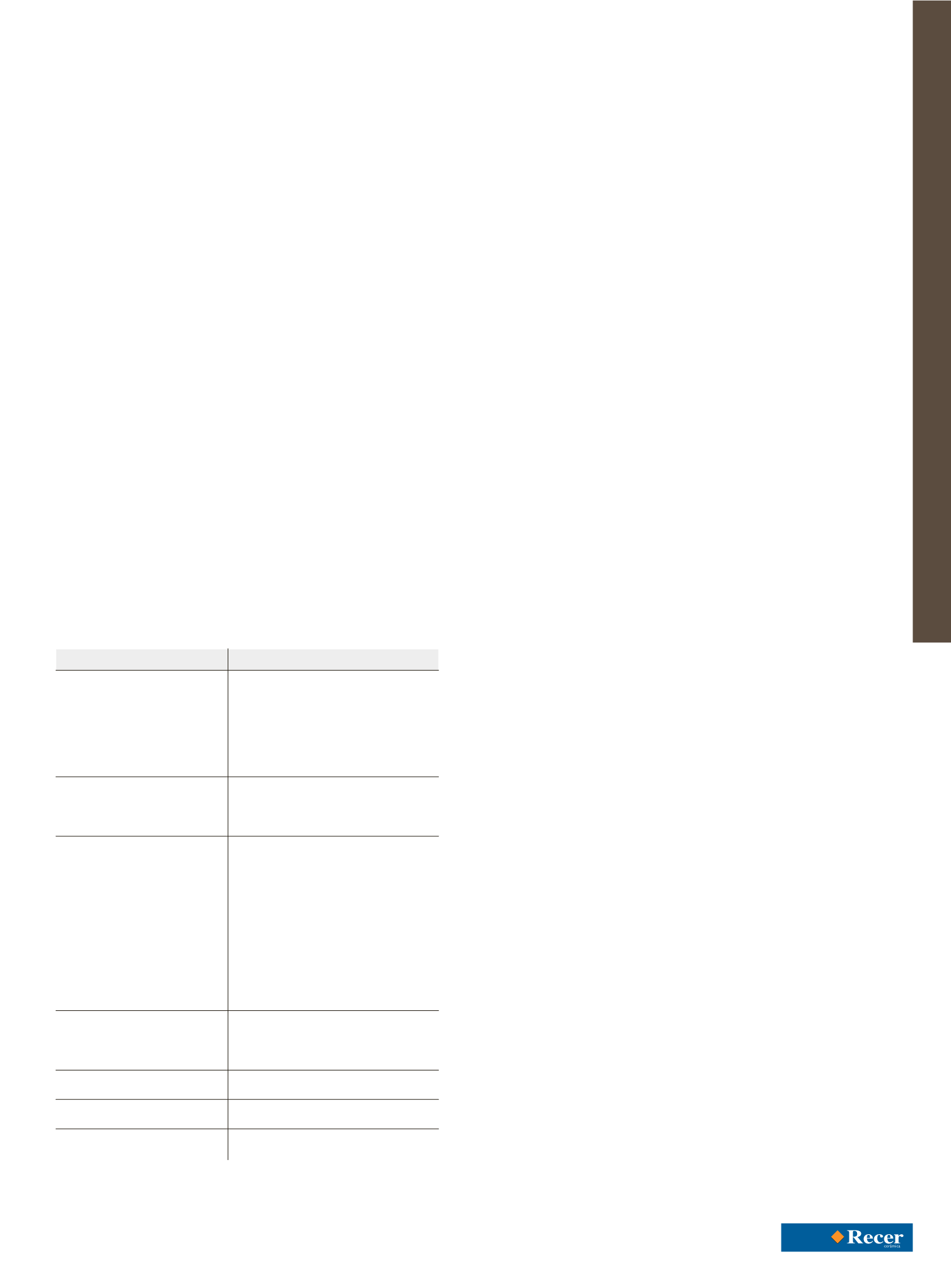
CARACTERÍSTICAS TÉCNICAS
TECHNICAL CHARACTERISTICS
| CARACTÉRISTIQUES TECHNIQUES
| TECHNISCHE MERKMALE
279
Cleaning and maintenance in use
Unglazed, polished or semi-polished porcelain tiles need special care when it comes
to cleaning certain stains.
Daily cleaning is easy and only requires a commercial detergent and clean water.
When cleaning specific stains, consult the table below.
Coloured stains (coee, wine, glue, grease, etc.) on porcelain products should be
cleaned straightaway with a damp cloth. Otherwise, you might need to use a specific
detergent to remove them.
Care should be taken with using specific commercial detergents (given their chemical
composition) to remove certain diÀcult marks such as paint because they can spoil
the surface of some glazed, polished and semi-polished tiles. Never use cleaners
containing hydrofluoric acid.
Special care is needed when using oily products (olive and other oils, waxes, etc.),
since they can form a film that causes an eect similar to waterproofing and can
change the colour of the tile. This can be quite hard to remove, depending on the type
of staining material and the age of the stain.
As a precaution, stronger cleaning agents should always be tested first on a small,
inconspicuous area to see their eects.
At Recer, all our products are tested in the laboratory. There are several firms selling
specific cleaning products for ceramic tiles. The table below lists some examples of
cleaning agents for specific types of dirt. This list of agents can be used as a guide
when choosing between the cleaning products on the market, based on their active
ingredient.
Acids and other concentrated chemical cleaning and maintenance products must
be used with care and in accordance with the instructions on their use that come
with the packaging and labels. Polished and semi-polished products must be sealed
immediately aÉer laying and before being grouted. Regarding sealing products, you
should first obtain all relevant information or perhaps even get in touch with the
manufacturer before choosing a cleaning product, treatment and/or waterproof
coating to make sure that you get the right product for the purpose.
Dealing with waste and leÃover material
Ceramic products are chemically inert and do not release any toxic or hazardous
substances. However, at the end of the work, all waste ceramics must be separated
and sent on as construction and demolition waste (CDW), in compliance with current
applicable legislation. Recer’s product packaging is developed together with our
suppliers, to ensure they do not incorporate hazardous substances. All the elements
of the packaging of Recer products are recyclable and should be separated by type
(plastic, cardboard and wood) and sent to the appropriate recipients to be exploited.
Whenever possible, waste should be separated on site and delivered to duly accredited
entities. Recycling (incorporation in productive processes) is favoured as the final
destination of waste material.
Porcelain tiles
Type of Dirt
Deposits/ Eorescence of:
Limescale
Ink
Rust
Oxidation
Cement
Beer / wine / Ice cream / coee / tea
Vegetable and animal fats
Urine / Vomit
Tyre marks
Resinous inks or enamel
Oil
Varnish
Grease
Wax crayon
Hair dye
Lipstick
Bitumen
Wax
Resins
Felt tip pens
Ketchup / Coca-cola / Vinegar
Methylene blue
Spray paint
Dirt in the grout
Daily cleaning
Acid-based detergent:
. Hydrochloric Acid
. Nitric Acid
. Sulphuric Acid
. Oxalic Acid
Alkaline-based detergent:
. Caustic soda
. Potash
Solvents:
. Trichloroethylene .
. Thinner
. Turpentine
. Acetone
. Alkaline-based detergents
. Acid
Specialist acid-based detergent
Specialist alkaline-based detergent
Ordinary detergent
Recommended Detergent or Solvent


